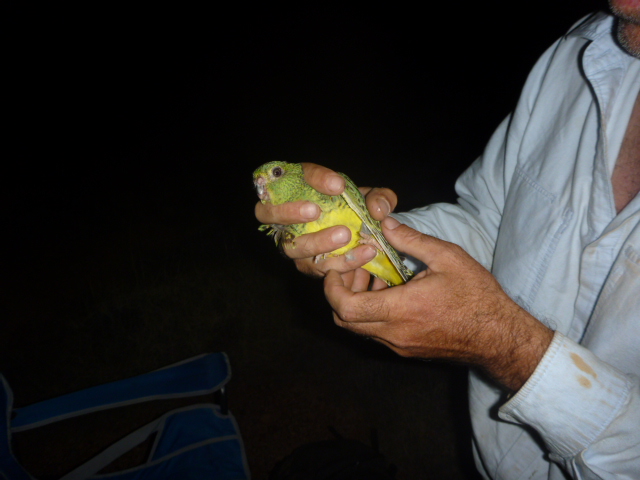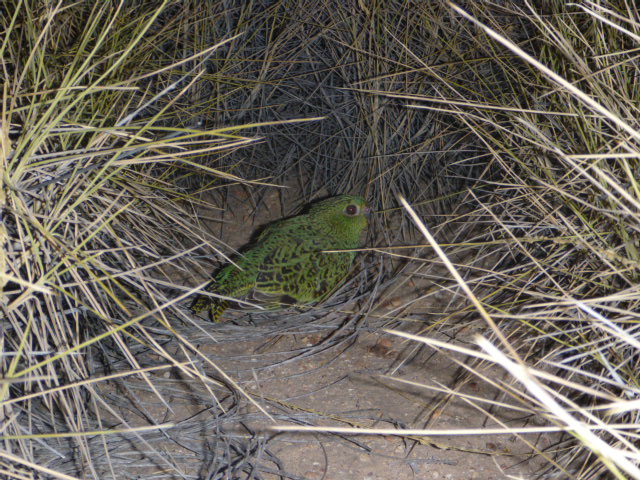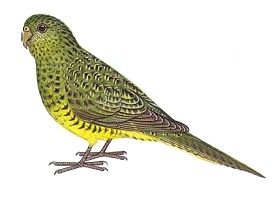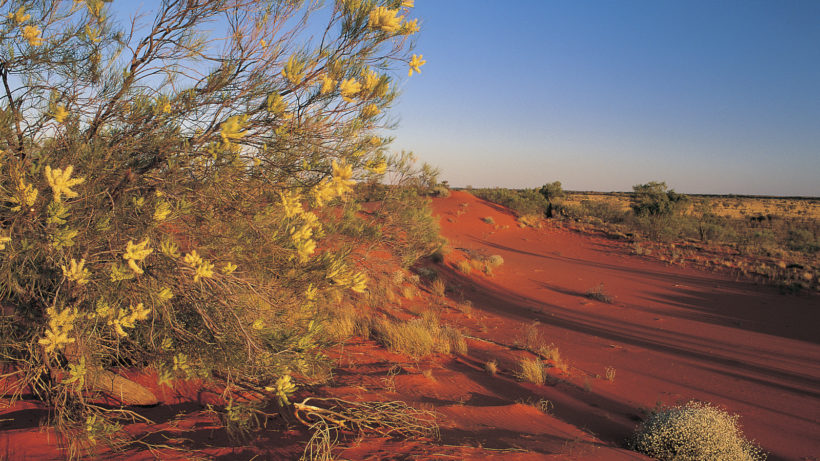April 4, 2015. Ornithologist Steve Murphy and Rachel Barr are tramping through the bush at a secret location in southwestern Queensland, Australia. And after searching for 18 months, they’ve finally found one of the world’s rarest birds — the Night Parrot.
Or rather, the bird found them, flying into a mist net they’d set up in the bush around 7:00 p.m. that evening.
It was the first time the species had been captured alive in the last century — undisputedly a major achievement for conservationists — at the only location where we know they can be reliably found.
This (re)re-discovery of alive and flapping Night Parrots prompted a surge of disbelief, amazement, and delight amongst birders, spawning references to the holy grail of ornithology and hilarious news headlines like: “Looking for a night parrot in a haystack? Found one.”
But now that a bird in hand firmly quells any rumors of extinction, where does that leave conservationists?
The Mysterious
Pezoporus occidentalis
The Night Parrot is the Australian equivalent of the Ivory-billed Woodpecker. But unlike the Ivory-billed Woodpecker, we’re absolutely certain that Night Parrots aren’t extinct.
And now we know where to find them.
Described (not inaccurately) by The Field Guide to the Birds of Australia as a “dumpy, olive-green parrot with a large head and eye,” this mottled parrot was once found throughout the spinifex habitat that blankets inland Australia.
Around 1900 a multitude of environmental problems caused the population to crash, including pastoral settlement, drought, altered fire regimes, invasive predators like fox and feral cat, and feral camels, which degrade and reduce water sources.
Despite news stories claiming that the bird was ‘back from extinction,’ Night Parrots were never formally classified as extinct on any federal list.
“There was debate and discussion on if the species still persisted, but there had always been enough uncertainty that there wasn’t consensus that it was extinct,” says Jim Radford, the science and research manager at Bush Heritage Australia.
But for quite a while extinction was a definite possibility. The last living Night Parrot was collected in Western Australia in 1912, and then the bird vanished into the vastness of the outback for 75 years.
Then in October of 1990, ornithologists found the dried-out carcass of a Night Parrot along Queensland’s Highway 83. Over the next two decades the sightings tricked in, tantalizing ornithologists and birders alike. Two biologists — surveying the Minga Well area in advance of mining activities — saw live parrots in 2005 and eventually published their findings three years later. In 2006 a second dead bird turned up, found headless beneath a barbed-wire fence in Diamantina National Park. Then in 2013, naturalist John Young captured photos and call recordings of a Night Parrot at an undisclosed location in southwestern Queensland.
But when you’re trying to protect the rarest bird in Australia, two dead birds and some shaky footage isn’t much to go on.

A Long List of Unknowns
The night parrot literally defines what it means to be elusive, escaping persistent and dedicated attempts to find it for nearly a century. That kind of evasion is downright admirable. But it’s also downright inconvenient.
“With this bird, its like mist in your hand,” says Radford. “How do you research something that you can’t find?”
The list of what scientists do know about night parrots — aside from not extinct — is short.
Consider the species description on the Australian government’s website: Distribution? “Very poorly understood.” Average lifespan and age at sexual maturity? Not known. Diet? Largely unknown. Population? Maybe 50 birds, maybe. Juvenile plumage? Probably similar to the adults.
Radford says that scientists didn’t even know what the nights parrot’s call was until two years ago, when Young recorded it, so the common technique of playing a recorded call to attract live birds was out of the question.
As far as potential habitat, the suspected range of the night parrot encompasses a vast stretch of the interior Australian continent — an area larger than Europe.
And even the bird’s weight was a mystery. The tracking technology Murphy used is comparatively primitive, because without knowing how much the bird weighed he had to come prepared with the lightest device possible.
With this bird, its like mist in your hand. How do you research something that you can’t find?
Jim Radford
Thankfully, Murphy’s work the last 18 months has gone a very long way to filling in the gaps.
After untangling the parrot from the net, Murphy and Barr glued a small radio transmitter to the parrot’s lower back. The transmitter has a battery life of 21 days, during which time they followed the bird on the ground and via helicopter to track the signals.
Murphy confirmed that the parrot does roost in spinifex, as previously suspected, but also that this parrot made predictable movements each night, flying at least 7 kilometers away from its roost site to habitats not dominated by spinifex. They also observed a second Night Parrot in a habitat dominated by a chenopod plant called Gidyea Burr (Sclerolaena sp).
“We do not know exactly what it was doing there, but it was a very important observation nonetheless,” says Murphy, “because it showed that Night Parrots do use this habitat.” That second Night Parrot was only the third one Murphy has ever seen.
Murphy and Barr also gleaned more information about the species’ calls. Thanks to Young’s 2013 recordings, scientists knew that the night parrots have a two-syllable call, a cadence described by Murphy as roughly: “ding-ding.” But the parrot they tracked roosted with another bird that had a three-syllable call: “ding de-ding.”
“This is important because it allows us to improve upon the Wildlife Acoustics sound recognition software that is proving to be the most reliable way to detect Night Parrots that we have tested,” says Murphy. The acoustic monitoring will continue for another 10 months, hopefully capturing a second rainfall event.

Camera Traps, Acoustic Meters, & Drones
Because one Night Parrot population isn’t enough to save the species, Murphy’s research aims to develop reliable survey methods for night parrots, to better understand both what habitats are important to the species and the key threats in those habitats, and then to then conduct surveys to identify new Night Parrot populations.
In the 18 months leading up to the April capture, Murphy experimented with various detection methods at the site where Young discovered parrots in 2013. When camera traps didn’t work, Murphy tried using acoustic recorders to detect the birds. Young’s early recordings, and subsequent ones collected by Murphy, are used to train an automated screening software to identify parrot calls.
Murphy says the method is proving reliable, allowing him to continually monitor the southwestern Queensland population and build a picture of peak calling times for the species.
So far, Murphy discovered that the parrots call much more frequently after above average rainfall. They also call more during the first hour after sunset, and then the calling resumes around midnight during wetter periods. “This suggested to us that the increased calling after rainfall might be related to breeding activity,” says Murphy.
Next, Murphy is planning on using drone technology to better understand exactly what habitats the parrots are using and to determine if the parrots do drink from surface water holes, as reported by naturalists from the 1800s.
He is also using his acoustic detection methods to search other locations where dead Night Parrots were collected or where historical records indicate a former population.
“No one is suggesting that this is the only place in Australia where they are,” says Radford, “we just don’t know of the others yet.”
Joined by Julian Reid from the Australian National University, Murphy recently visited all of the historical eight locations to deploy acoustic recorders. “This included the very first place where Night Parrots were ever collected by the explorer John McDouall Stuart on Captain Charles Sturt’s expedition through northern South Australia in 1845,” says Murphy.

Can We Get from Resurrection to Recovery?
Murphy’s work is a breakthrough for conservation, but it’s worth noting that the (re)re-discovery is not merely a happy ending to years of dedicated searching — it’s the very beginning of a long hard road for conservationists and scientists.
“We’re still very much at the start of this research journey,” says Radford, “and having a population is very important.”
Bush Heritage Australia, a conservation nonprofit, is currently purchasing 56,000 hectares of land at the secret location where Murphy captured and tracked the night parrot.
“Steve’s research has show that the species has been there consistently for last two years, when previously they were thought to be highly nomadic,” says Radford. “That helps us have a bit more confidence that securing a property for a reserve to try to protect this species is worthwhile.”
After securing the property, the first step will be to design fire management plans to control burning.
“One of the reasons we think that the night parrot persists in this area is because it hasn’t been burned for a very, very long time,” says Radford. They suspect that the absence of fire has allowed the spinifex to grow to a density and structure preferable to night parrots.
Bush Heritage also plans to control non-native predators, like cats, which are a major threat to these nocturnal, ground-dwelling birds.
Murphy says that Bush Heritages’ negotiations with the current landowner were incredibly important to the future of Night Parrot conservation. The known Night Parrot habitat will be protected, but the landowner will be able to continue raising cattle on the rest of his property. Murphy hopes that this balance will assure other landowners in southwestern Queensland that the presence of a threatened species on their property doesn’t mean that they’ll lose their land.
“It shows that conservation and primary production can work together effectively for a great conservation outcome,” he says. “No-one, including cattle producers, want to see the further loss of native species.”

Lessons from the Desert Rat-kangaroo
As far as they know, Murphy and Barr are the only people alive who have ever held a Night Parrot, while Barr is the only woman alive to have ever definitely seen one.
“It’s a funny feeling being in this category,” says Murphy, “but it’s not really a happy feeling or one filled with excitement.”
He explains that Australia — famous as an epicenter of Anthropocene extinction, especially among mammals — has been in a similar situation before. In 1931, mammologist H. H. Finlayson traveled to South Australia to search for the desert rat-kangaroo (Caloprymnus campestris), which was thought to be almost certainly extinct. They found the rat, but shortly afterward the species completely disappeared and is now, once again, presumed extinct.
“My greatest fear is that we would repeat the mistake of missing perhaps the last opportunity to protect Night Parrots in the same was that we missed the opportunity to save Caloprymnus” says Murphy.
Hopefully, the Night Parrot’s hapless charm and mythic legend — and dedicated efforts of Murphy, Bush Heritage Australia, and others — will help prevent this moment from being the bird’s swan song before actual extinction.



Quite the accomplishment to find such a rare bird, especially when it hasn’t been sighted for such a prolonged period of time.
Great article, but I didn’t think John Young’s footage was shaky. His photos were certainly very clear.